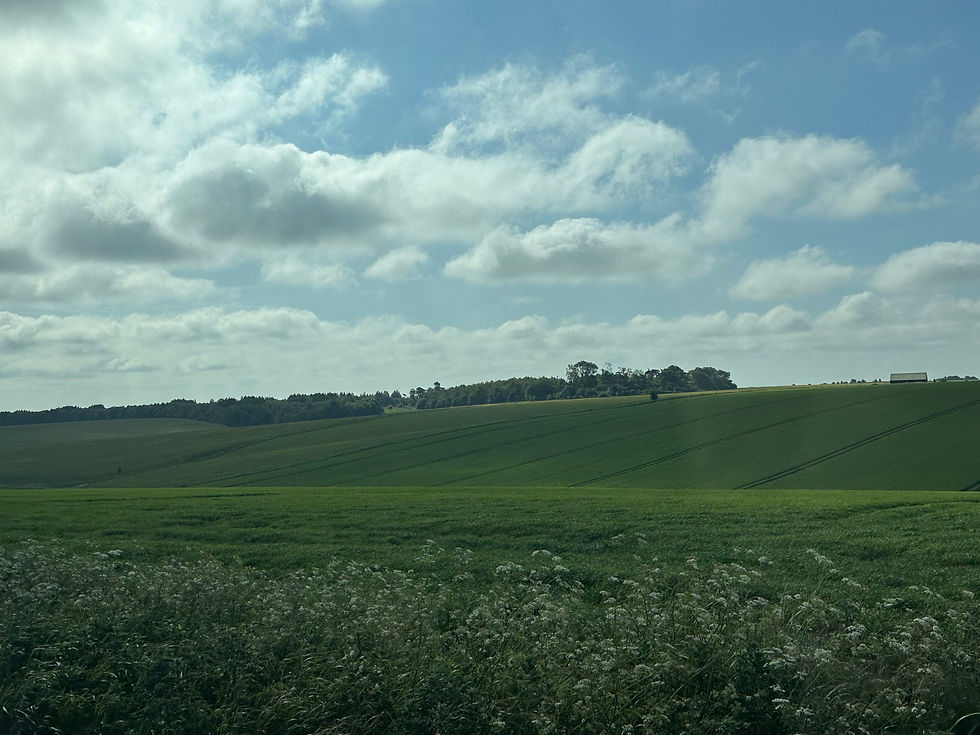Stones, you say?
- k8sibley
- Jun 6, 2023
- 3 min read

This is a region rich in stones, all of which have their own stories to tell. And their histories are interlaced with those of the humans who have traveled and resided in this area for millennia. There's a reason that both Bath and Stonehenge are on the list of UNESCO's World Heritage Sites. It's cultural, but so much if that culture is in response to what the stones have provided over the centuries.
On our first full day in Bath, we arrived early for our Mad Max tour with Sean, our guide for the day. Sean is a retired economics teacher, and it's clear he loves to teach and tell stories pertinent to the matter at hand.
We set off for our long day's journey into...

...the countryside and Stonehenge, our first stop on this adventure. No doubt about it, these are huge stones--even the small stones are bigger than imagination can conjure up.

But what is even more impressive is to recognize how these were assembled into a carefully planned design--created over a couple of millennia. How does one even do that kind of long term planning to ensure that it gets built as designed by so many generations of builders later?
So in the almost 5,000 or so years that Stonehenge has been around, in at least six stages of building and later stages of damage and deterioration, millions of humans have visited. To worship? Consider the solar system? Bury and mourn their dead? Or just stand and gape in awe? All of this and more--theories abound, but with no definitive answers. And discoveries continue to be made, expanding the possibilities for even more theories. The culturally historical area grows as scientists make new discoveries in the surrounding area. The number of visitors grows exponentially. I love that the mystery outlives every generation. And who knows?--perhaps the awe and the making was the only intent, similar to today's land art installations by Andy Goldsworthy.

That there was originally a full circle with these lintel stones set on the pillar stones with a ball-and-socket system is just so hard to believe. But you can see the carved ball on top of the tallest pillar. And there are lintel stones lying inside that circle that have the sockets carved into them.

Two of the millions of visitors to Stonehenge.

A road marker for some of the relatively recent visitors.

Two staff members watching over the site

This one deserves its own focus (first rook we've ever seen!).
Our guide had us on a very full schedule, with many miles to go crisscrossing the Salisbury Plain, so back to our bus we went, with a brief stop at the cafe to pick up a lunch for later--and a cheesy pasty for immediate consumption. The cheese was good, but the onions were abundant and odoriferous--what is it with this "mature cheddar and onions" thing??? Why can't they just do cheese in all its solitary delicious splendor? Because I was wearing a mask in the bus so my cough wouldn't excessively alarm our fellow travelers, those onions were omnipresent for the rest of the day. 🫢
Next stop: a small village where Sean wanted to show us how thatched roofs are built:

The straw is bundled, packed onto the roof and trimmed. When it's completed, nowadays they put a wire mesh over all of it to ensure it lasts as long as possible. Many of the best thatchers have individual signatures that they leave on the ridge of the roof--a squirrel, or bird of some sort; something that will be recognized by homeowners needing their roofs rethatched. The law requires that, if your house has a thatched roof, you must replace it when the time comes with another thatched roof. You can't switch to asbestos shingles or even slate or any other material. Apparently, however, a well-thatched roof can last 20-25 years.

At this village, we also visited a church built principally of flint, which is pretty abundant in that area. I think that might be what makes St. Bartholomew's in London (see "There be dragons here" for a pic of that) so visually appealing.

Sean explains this church's construction materials. More stone stories.

As I recall, this roof ridge was decorated in this manner to make it difficult for witches to enter.
Despite falling further behind, I must close down for tonight. I had written most of this today on the train to Amsterdam, but somehow lost the entire thing along the way. Grrrrr... So look tomorrow for more stone ruminations.



I'm loving the pictures and all the descriptions! Looks like you two are having a GREAT time.
Looking forward to seeing you in Austria at the end of the month!
If have a chance, please email me the info about our lodging in Prague and Vienna.
😃
Your pictures make me want to get out my old photographs of Stonehenge. They don’t compare with your great phone pictures. And you have them immediately without having to take rolls and rolls of film home to be developed, hoping you have something worth looking at. After our visit to Stonehenge, we stopped to see the remainders of an old castle. A group of teenage students were visiting the sight. A few girls passed us by and were listening to us speaking to each other. We heard them say, “Oh, don’t you just love the American accent.” We laughed and turned to them saying, “We thought you had the accent!” Which made them laugh. Then we had a fun conversati…